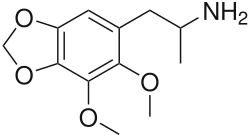 | |
| Identifiers | |
|---|---|
| |
| CAS Number |
|
| PubChem CID | |
| ChemSpider | |
| UNII | |
| ChEMBL | |
| CompTox Dashboard (EPA) | |
| Chemical and physical data | |
| Formula | C12H17NO4 |
| Molar mass | 239.271 g·mol−1 |
| 3D model (JSmol) | |
| Melting point | 178 to 180 °C (352 to 356 °F) |
| |
| |
| | |
DMMDA-2 is a bioactive phenethylamine discussed by Alexander Shulgin in his book PiHKAL (Phenethylamines i Have Known And Loved) ; however, he was not the first to synthesize it. [1] Shulgin comments in his book that a 50 milligram dose of DMMDA-2 produces similar effects to MDA. [1] DMMDA-2 can be synthesized from dillapiole. [1] DMMDA-2 is equivalent in potency to 5 mescaline units. DMMDA-2's isomer DMMDA is equivalent to 12 mescaline units. [2]